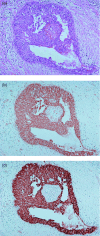Immunohistochemical expression of the beta-catenin-interacting protein B9L is associated with histological high nuclear grade and immunohistochemical ErbB2/HER-2 expression in breast cancers
- PMID: 17309600
- PMCID: PMC11158702
- DOI: 10.1111/j.1349-7006.2007.00430.x
Immunohistochemical expression of the beta-catenin-interacting protein B9L is associated with histological high nuclear grade and immunohistochemical ErbB2/HER-2 expression in breast cancers
Abstract
B9L/BCL9-2, a novel beta-catenin-interacting protein, plays an important role in colorectal carcinogenesis by translocating beta-catenin to the nucleus and enhancing beta-catenin-T-cell factor-mediated transcription. To elucidate the role of B9L in breast cancers, we studied B9L expression in ductal carcinoma in situ (DCIS) and invasive ductal carcinoma (IDC) of the breast immunohistochemically and compared it to the immunohistochemical expression of known proteins involved in breast carcinogenesis. In breast tissues, B9L immunoreactivity was present exclusively in the nuclei of normal and neoplastic ductal cells. In DCIS, immunohistochemical B9L expression was significantly associated with the tumor nuclear grade, comedo necrosis and the expression of ErbB2/HER-2, c-myc and p53. In IDC, B9L expression was correlated with ErbB2/HER-2 expression and tumor nuclear grade only. In both DCIS and IDC, immunohistochemical B9L expression was not related to the expression of cytoplasmic beta-catenin. We demonstrated that nuclear B9L expression was closely associated with the high nuclear grade cancer phenotype and the expression of ErbB2/HER-2 in breast cancers.
Figures




Similar articles
-
Abnormal expression of Nek2 and β-catenin in breast carcinoma: clinicopathological correlations.Histopathology. 2011 Oct;59(4):631-42. doi: 10.1111/j.1365-2559.2011.03941.x. Histopathology. 2011. PMID: 22014044
-
[Expression of fatty acid synthase and its association with HER2 in invasive ductal carcinoma of breast].Zhonghua Bing Li Xue Za Zhi. 2013 Apr;42(4):257-61. doi: 10.3760/cma.j.issn.0529-5807.2013.04.010. Zhonghua Bing Li Xue Za Zhi. 2013. PMID: 23928534 Chinese.
-
p14ARF expression in invasive breast cancers and ductal carcinoma in situ--relationships to p53 and Hdm2.Breast Cancer Res. 2004;6(5):R571-85. doi: 10.1186/bcr912. Epub 2004 Jul 29. Breast Cancer Res. 2004. PMID: 15318938 Free PMC article.
-
Alterations of estrogen receptors, progesterone receptors and c-erbB2 oncogene protein expression in ductal carcinomas of the breast.Cell Biol Int. 2008 Jun;32(6):698-707. doi: 10.1016/j.cellbi.2008.01.007. Epub 2008 Jan 25. Cell Biol Int. 2008. PMID: 18296077
-
Expression of cytokeratin markers, ER-alpha, PR, HER-2/neu, and EGFR in pure ductal carcinoma in situ (DCIS) and DCIS with co-existing invasive ductal carcinoma (IDC) of the breast.Ann Clin Lab Sci. 2007 Spring;37(2):127-34. Ann Clin Lab Sci. 2007. PMID: 17522367
Cited by
-
Identifying Methylation Pattern and Genes Associated with Breast Cancer Subtypes.Int J Mol Sci. 2019 Aug 31;20(17):4269. doi: 10.3390/ijms20174269. Int J Mol Sci. 2019. PMID: 31480430 Free PMC article.
-
miR-766-3p Targeting BCL9L Suppressed Tumorigenesis, Epithelial-Mesenchymal Transition, and Metastasis Through the β-Catenin Signaling Pathway in Osteosarcoma Cells.Front Cell Dev Biol. 2020 Oct 7;8:594135. doi: 10.3389/fcell.2020.594135. eCollection 2020. Front Cell Dev Biol. 2020. PMID: 33117820 Free PMC article.
-
Expression profiling of in vivo ductal carcinoma in situ progression models identified B cell lymphoma-9 as a molecular driver of breast cancer invasion.Breast Cancer Res. 2015 Sep 17;17:128. doi: 10.1186/s13058-015-0630-z. Breast Cancer Res. 2015. PMID: 26384318 Free PMC article.
-
BCL9 promotes tumor progression by conferring enhanced proliferative, metastatic, and angiogenic properties to cancer cells.Cancer Res. 2009 Oct 1;69(19):7577-86. doi: 10.1158/0008-5472.CAN-09-0773. Epub 2009 Sep 8. Cancer Res. 2009. PMID: 19738061 Free PMC article.
-
The BCL9-2 proto-oncogene governs estrogen receptor alpha expression in breast tumorigenesis.Oncotarget. 2014 Aug 30;5(16):6770-87. doi: 10.18632/oncotarget.2252. Oncotarget. 2014. PMID: 25149534 Free PMC article.
References
-
- Polakis P. Wnt signaling and cancer. Genes Dev 2000; 14: 1837–51. - PubMed
-
- Bienz M, Clevers H. Linking colorectal cancer to Wnt signaling. Cell 2000; 103: 311–20. - PubMed
-
- Cadigan KM, Nusse R. Wnt signaling: a common theme in animal development. Genes Dev 1997; 11: 3286–305. - PubMed
-
- Akiyama T. Wnt/beta‐catenin signaling. Cytokine Growth Factor Rev 2000; 11: 273–82. - PubMed
-
- Jamora C, Fuchs E. Intercellular adhesion, signalling and the cytoskeleton. Nat Cell Biol 2002; 4: E101–8. - PubMed
Publication types
MeSH terms
Substances
LinkOut - more resources
Full Text Sources
Medical
Molecular Biology Databases
Research Materials
Miscellaneous

